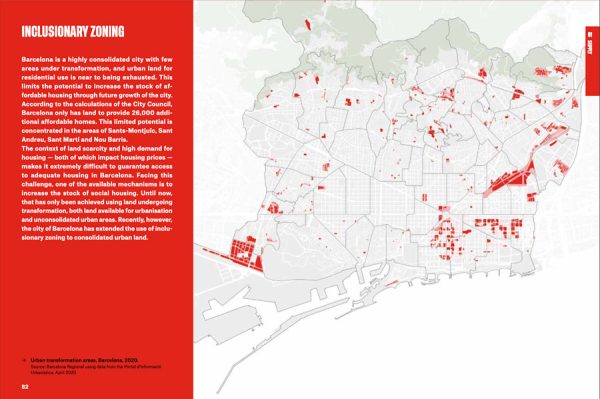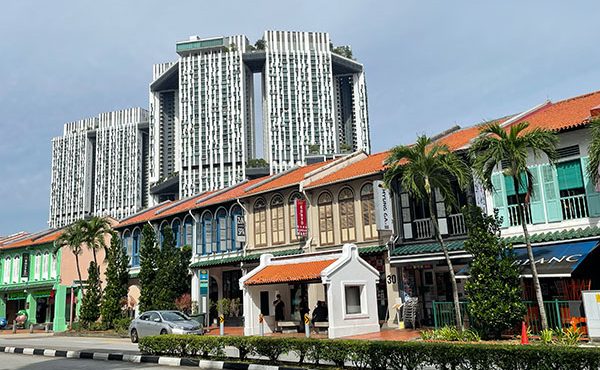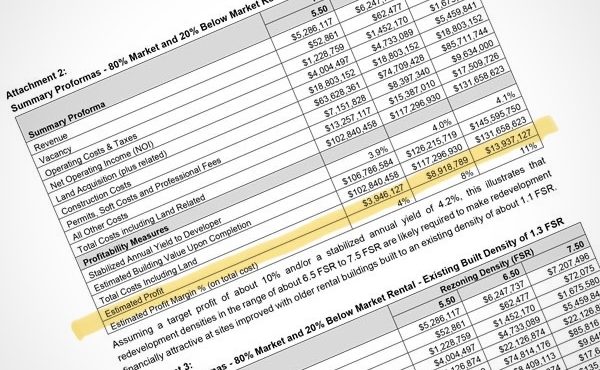
The intricacy and thoughtfulness of Barcelona’s housing policies were clear in Eduard Cabré Romans’ presentation. His patience shone as our BC planners asked question after question. However, a few issues stood out, particularly Barcelona’s inclusionary zoning regulations and related measures.
One notable policy is the “30% Measure” from the Barcelona Housing Policy 2015-2023, which mandates that 30% of all new housing developments and major renovations in as-of-right projects must be allocated as affordable housing.
Another
key policy focuses on Green Fields and Brownfields where developments must reserve 40% of land for Officially Protected Housing (HPO), with half of these units designated as rental. In addition, the Municipality receives 10% of all development rights free of charge to further affordable housing projects.
These measures wouldn’t be possible without strong public-private partnerships, which sparked an interesting discussion. Finally, an innovative idea—a rental registry to ensure compliance with rent regulations—also gathered a lot of attention.
Let’s briefly explore each issue
The “30% Measure”
The inclusionary zoning requirement clearly mandates that new residential projects and major refurbishments—buildings over 600 square meters/6,500 square feet—must allocate 30% of units for affordable housing, following the City’s strict definition and criteria.
This pioneering instrument, enacted at the State level, aims to ensure a balanced mix of housing types and foster socio-economic diversity in Barcelona. It targets a broad range of housing projects in well-established and newly developed areas to evenly distribute affordable housing.
The affordability criteria ensure that these units remain accessible to low- and moderate-income households, with rent and sale prices capped 60%-80% below market rates and permanent affordability guaranteed by law since 2019.
The Barcelona government is responsible for monitoring compliance with the 30% Measure, through organizations such as the Barcelona Metropolitan Housing Observatory (O-HB), requiring that developers submit detailed plans demonstrating how their projects will meet this inclusionary housing obligation.
The main goal is to increase affordable housing stock and reduce displacement caused by rising property prices and gentrification. However, the city must carefully balance market conditions and the financial viability of projects to ensure compliance with the 30% Measure without halting development. As such, the city provides support to developers to facilitate the inclusion of affordable units while maintaining the overall feasibility of housing projects.
Affordability Requirements in Green Fields and Brown Fields
This zoning is required at the Barcelona and the Metropolitan Area (AMB) level, and focuses on increasing land reserves for Officially Protected Housing (HPO) and affordable housing.
It requires that in designated urban transformation areas—typically, large lot developments—the developer must allocate 40% of land for HPO, with half of these units reserved for rent. For existing plots and buildings being retrofitted outside of these areas the 30% Measure still applies.
Additionally, the municipality receives 10% of all development rights for free, in these areas. Due to the lower value of land zoned for affordable housing compared to market housing, the municipality often ends up with 20% to 25% of land being designated for affordable housing through public-private partnerships, leveraging their public-private partnerships.
Public-Private Partnerships
Barcelona’s public-private partnerships play a crucial role in affordable housing. Unfortunately, an in-depth look at this complex system is beyond the scope of this article. Two elements are worth noting, however. First, is the ESAL Framework Agreement whereby the City leases land to cooperatives and social housing developers to build and manage over 1,000 units of permanently affordable housing.
This is supplemented by Habitatge Metropolis Barcelona—a mixed-economy development company-owned 25% Barcelona City Council, 25% AMB, 50% private developers (NEINOR and CEVASA) selected through public procurement. This entity alone has developed 4,500 rental units in Barcelona and nearby municipalities.
Housing Purchases
Since building new housing is a complex, expensive undertaking relying on land availability, Barcelona’s multi-pronged approach includes a purchasing strategy. Under the Right to Housing Plan, the city declared itself a “pre-emptive purchase” area, giving the municipality the first right to buy any property entering the market.
This allows for an even distribution of social and affordable housing and creates the unique condition where affordable units have been purchased within existing market developments. In certain circumstances, this was provided to allow households to age in place. In the words of Javier Burón, this is “probably the most interesting new instrument” developed out of their policy innovations.
Rent Regulations
Barcelona has a unique registry that ensures landlords cannot raise rents between tenants, effectively preventing renovictions. This applies to all private rental contracts, and requires that all fees—including 1- or 2-month deposits—are submitted to Incasol (Catalan Land Institute): an existing agency that has been managing rental contracts for a long time. Thus, previous rental prices are known to incoming renters and can be tracked over time.
Additionally, landlords must specify previous rents in new contracts, highlighting increases based on the permitted annual indexed increase or due to improvements. As one can imagine, the British Columbian’s were left breathless.
An hour beyond our scheduled time and with no end in sight, we felt we had pushed Eduard Cabré Romans’ incredible generosity to its limit, despite his kind gestures otherwise.
We covered a lot of ground—from the complexity of managing affordable housing in a rapidly growing city to the challenges of maintaining a balance between historical preservation and modern development. Each question was answered with a blend of practical insights and strategic foresight, underscoring the nuanced approach required to navigate these multifaceted challenges.
Despite the complexity, seven key lessons were learned through Eduard Cabré Romans’ journey in affordable housing. These will play significant roles in the comparison between Vancouver and Barcelona policies in the articles to follow. They are briefly summarized here in no clear order of importance.
- Improving the lives of all citizens must guide political decisions at all levels. A city is its people. The motivation behind all policies and decisions should be to improve the lives of all citizens. Citizens come first.
- The market can and should be held at arm’s length. Blindly having faith in the market to provide affordable housing is bound for failure. The City needs to control the market, not the other way around.
- Clear definitions for terms like “affordable housing” and “social housing” are necessary to prevent vagueness and manipulation. Ambiguity harms everyone and opens the doors to corruption.
- A mix of housing types is needed to foster diverse communities and support vulnerable households. Affordable housing must address vulnerable urban households to allow them to gain stability, build community, and feel included. No single build type should be biased for the delivery of affordable housing. Offerings for diverse populations require diverse housing.
- Partnerships between public, private, and community groups are crucial, especially with limited government funding. All parties must work closely together to ensure success. Attempting, for example, to remove community feedback and input like the City of Vancouver will lead to failure and unrest.
- Affordable housing requires creative capital solutions—from purchasing to renovating. Consider the public-private partnerships necessary for the diversity of Barcelona’s that include but are not limited to building, purchasing, renovating, and managing rental properties.
- Policies must be evidence-based. Anecdotes and fictional narratives are destructive. Housing is too important.
- Evidence-based policies require investment in collecting and managing data and conducting research. In Barcelona, this involved the creation of the Barcelona Metropolitan Housing Observatory (O-HB) but it can take other forms. Regardless, data must be gathered, managed, and analyzed continually.
- None of this is possible without strong political will and full commitment to providing affordable housing. The Colau administration was the catalyst for Barcelona’s diversity of housing-related initiatives, holding steadfast against the standard market-driven, profit-focused pressures in the name of creating a better city for Barcelona’s citizens.
With sincere gratitude, our British Columbia delegation wished Cabré Romans the best and stepped back onto Carrer del Dr. Aiguader buzzing with excitement, eager to see how we could bring these lessons back to British Columbia.
We are now ready to see how our local policies measure up to Barcelona’s…
***
Other pieces in the Barcelona Chronicles:
- Part 1 – Introduction
- Part 2 – Cerdà and Colau: Two Key Figures
- Part 3 – The Barcelona Housing Policy 2015-2023 Overview
- Part 4 – Defining Affordable & Social Housing
- Part 5 – Supplying Affordable Housing
- Part 7 – Vancouver v. Barcelona – Foundations
- Part 8 – Barcelona v. Vancouver – Strategies
- Part 9 – The Eixample and the Superilla
- Part 10 – The Superilla Pilot
- Part 11 – The Superilla…Evolved
- Part 12 – Vancouver v. Barcelona – Urban Design
- Part 13 – Reflections on Two Cities
**
Erick Villagomez is the Editor-in-Chief at Spacing Vancouver and teaches at UBC’s School of Community and Regional Planning. He is also the author of The Laws of Settlements: 54 Laws Underlying Settlements Across Scale and Culture.




